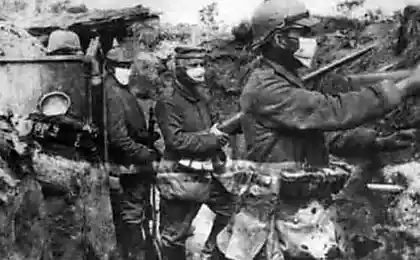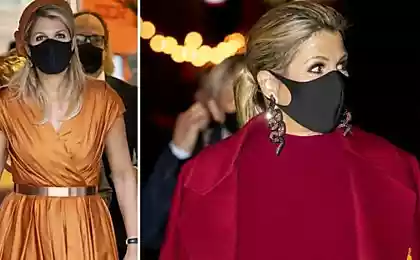1087
History of the goalie mask (9 photos)
Those of us who have ever held in my hands a hockey puck and can imagine what a speed of 150 km / h, it is difficult to surprise the fact that hockey goalies wear masks. But among that over the years they put on their faces, there are many amazing.
However, the most surprising is how long goalkeepers stood with uncovered faces completely before rushing at them with speed bomber taking off pieces of frozen rubber. Your correspondents are part-time father of a hockey goalie, think about it and scared. Nevertheless, it is a fact: the mask has become an integral part of the ammunition goalkeeper relatively recently - in the second half of the last century. And not all goalkeepers, believe it or - no, gladly accepted this invention. However, given the fact that they are all just got the puck on nothing but the skull, the brain is not protected, something to believe in such nonsense is just not difficult.
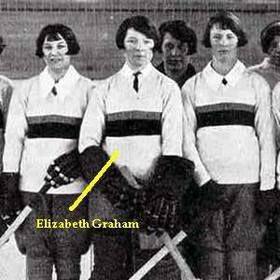
As it is easy to believe that the pioneer who tried (albeit unsuccessfully) to send these masochists on the right path, was ... a woman. The earliest mention of a shot, protects the face, refers to 1927, when the women's team goalkeeper at Queen's University in Kingston (Ontario) Elizabeth Graham took to the ice in a mask for fencing.
Elizabeth went to such measures not because of their own timidity, and at the insistence of his father. Graham Sr. just spent a lot of money to repair the teeth its shiftless hockey daughter and did not want to go to new spending.
In men, the first known mask appeared at about the same time. Anyway, on a postcard depicting the match in Switzerland between the local team and the Americans, the visitors' (his name in history has been preserved) protects the gate, wearing a face iron "cage" for the game of baseball. At the 1936 Olympics is about the same construction put goalkeeper Japan Teytszi Honma. He wore glasses, and owl outlines this particular baseball mask fits him perfectly.
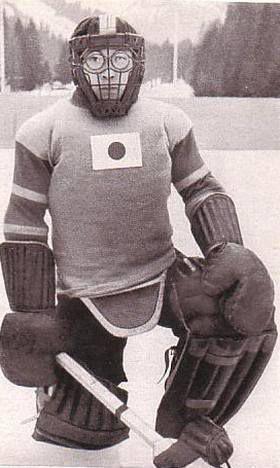
Around the same time, another goalkeeper, bespectacled, Canadian Roy Musgrove, speaking in a British club "Wembley Lions", put on a special wire mesh, it protects only the eyes. "Mask" Musgrove was taken from the national sport of North American Indians - lyakrosa (lyakrose in women, where there is no contact, but there is a real chance to get a stick in the eye, such gizmos are so far).
Tried something similar and the goalkeeper the US Olympic team in 1932, Franklin Farrell. But the pictures he, of course, shows a much more mature age.
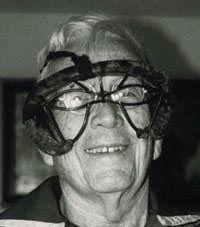
Borrowing from other sports are not very help, and sometimes simply prevented goaltenders see the puck, so in the future hockey went only by his.
In the first attempt to protect NHL goalie full face was made in 1930, goalkeeper "Montreal Maroons' Clint Benedict, who has managed to get the puck in the face in two straight games. The first blow cut his face and caused a concussion, and the second (three days later) - broke his nose and cheekbone. Benedict returned to the ice for a month, wearing face awesome armor of leather and wire, covered his nose, mouth and forehead, but his eyes and ears.
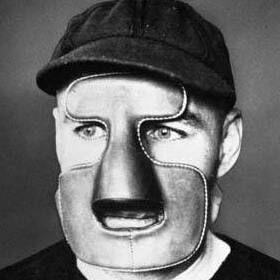
Long to play in this muzzled Benedict could not - a huge leather "nose" prevented him from seeing. Toward the end of that season puck thrown legend "Montreal Canadiens" Howie Morentsem, Benedict hit in the throat, and goalkeeper inventor was forced to retire. Oddly enough, his courageous and tragic example is not served immediate incentive to improve the goalie ammunition.
Only in 1954 was made the next attempt, when a Canadian craftsman sent a sample of all six NHL mask-visors made of transparent plastic. One of them shows the photograph goalkeeper "Toronto" Johnny Bower. However, these structures instantly fogging and goalkeepers, try them in training, said the inventor of a categorical refusal.

Goalkeeper revolution occurred only in 1959, and became leader of one of the greatest goalkeepers of all time - the legendary Jacques Plante of the "Montreal Canadiens." Genius, nonconformist, eccentric (his hobby, for example, was knitting), innovator (one of the first out of the gate, giving passes partners have facial rim) - in short, the ideal candidate to revolutionaries. As is the case with Benedict, Plante donned the mask is not a good life: Jacques once again hit the hockey training in the face, shattering with the cheekbone. Then he gave an interview to a radio station in Montreal, which appealed to fans to help him find a suitable mask. One student volunteered to make Jacques fiberglass mold to the contours of his face. Plant tested the mask in the preseason training camp that scary not like his coach - a staunch conservative Toe Blake. He believed that the mask will limit the visibility of the goalkeeper and creating a sense of security he does not allow to focus on the game.
However, January 1, 1959 dashing "click" Player "Rangers' Andy Bathgate ended for Plant dissected cheek.

Goalkeeper went to the locker room, where he had stitches (the game had to be stopped for 45 minutes), and refused to return until he was allowed to wear a mask. Blake raged and cursed, but Plante was adamant. He knew that a player of his caliber can dictate its terms even such a dictator as Blake. Moreover, that substitute goalkeeper in "Montreal" was not.
Revolutionaries had a hard time. Fans mocked, the press branded him a coward, Blake continued to rant and rave. But Plantu has always been spit on someone else's opinion, and in the end, his example was contagious. In the 1960s, the majority of NHL goalies saw the light and realized that to go through life the written handsome much nicer than the pizza instead of a face. Or to whom it is not applied to a greater extent than Terry Sawchuk of "Detroit" whose face after numerous hits the puck itself was like a scary mask.
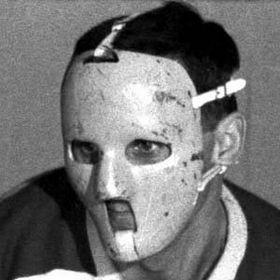
(This famous photograph scars Savchuk were slightly isolated make-up artist, but the crazy look of this very difficult and very unhappy man - the real.) The mask that Savchuk eventually wore was very primitive and made him look like Frankenstein's monster. Which in this case was a step forward in terms of beauty.
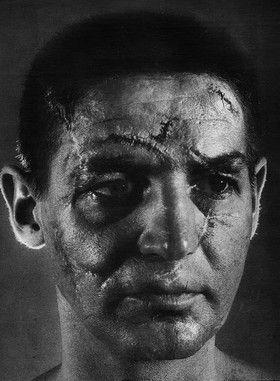
Fiberglass, pliable material, could be made to the shape of the face goalkeeper or bound in a cage. This "mask-pretzel" later started wearing Plant, followed by Ken Dryden
And in 1968, the year of the goalie ammunition there was a new revolution - not so important, but no less remarkable: the first painted mask.
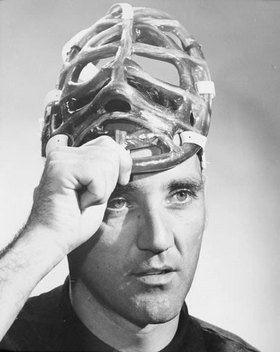
However, the most surprising is how long goalkeepers stood with uncovered faces completely before rushing at them with speed bomber taking off pieces of frozen rubber. Your correspondents are part-time father of a hockey goalie, think about it and scared. Nevertheless, it is a fact: the mask has become an integral part of the ammunition goalkeeper relatively recently - in the second half of the last century. And not all goalkeepers, believe it or - no, gladly accepted this invention. However, given the fact that they are all just got the puck on nothing but the skull, the brain is not protected, something to believe in such nonsense is just not difficult.

As it is easy to believe that the pioneer who tried (albeit unsuccessfully) to send these masochists on the right path, was ... a woman. The earliest mention of a shot, protects the face, refers to 1927, when the women's team goalkeeper at Queen's University in Kingston (Ontario) Elizabeth Graham took to the ice in a mask for fencing.
Elizabeth went to such measures not because of their own timidity, and at the insistence of his father. Graham Sr. just spent a lot of money to repair the teeth its shiftless hockey daughter and did not want to go to new spending.
In men, the first known mask appeared at about the same time. Anyway, on a postcard depicting the match in Switzerland between the local team and the Americans, the visitors' (his name in history has been preserved) protects the gate, wearing a face iron "cage" for the game of baseball. At the 1936 Olympics is about the same construction put goalkeeper Japan Teytszi Honma. He wore glasses, and owl outlines this particular baseball mask fits him perfectly.

Around the same time, another goalkeeper, bespectacled, Canadian Roy Musgrove, speaking in a British club "Wembley Lions", put on a special wire mesh, it protects only the eyes. "Mask" Musgrove was taken from the national sport of North American Indians - lyakrosa (lyakrose in women, where there is no contact, but there is a real chance to get a stick in the eye, such gizmos are so far).
Tried something similar and the goalkeeper the US Olympic team in 1932, Franklin Farrell. But the pictures he, of course, shows a much more mature age.

Borrowing from other sports are not very help, and sometimes simply prevented goaltenders see the puck, so in the future hockey went only by his.
In the first attempt to protect NHL goalie full face was made in 1930, goalkeeper "Montreal Maroons' Clint Benedict, who has managed to get the puck in the face in two straight games. The first blow cut his face and caused a concussion, and the second (three days later) - broke his nose and cheekbone. Benedict returned to the ice for a month, wearing face awesome armor of leather and wire, covered his nose, mouth and forehead, but his eyes and ears.

Long to play in this muzzled Benedict could not - a huge leather "nose" prevented him from seeing. Toward the end of that season puck thrown legend "Montreal Canadiens" Howie Morentsem, Benedict hit in the throat, and goalkeeper inventor was forced to retire. Oddly enough, his courageous and tragic example is not served immediate incentive to improve the goalie ammunition.
Only in 1954 was made the next attempt, when a Canadian craftsman sent a sample of all six NHL mask-visors made of transparent plastic. One of them shows the photograph goalkeeper "Toronto" Johnny Bower. However, these structures instantly fogging and goalkeepers, try them in training, said the inventor of a categorical refusal.

Goalkeeper revolution occurred only in 1959, and became leader of one of the greatest goalkeepers of all time - the legendary Jacques Plante of the "Montreal Canadiens." Genius, nonconformist, eccentric (his hobby, for example, was knitting), innovator (one of the first out of the gate, giving passes partners have facial rim) - in short, the ideal candidate to revolutionaries. As is the case with Benedict, Plante donned the mask is not a good life: Jacques once again hit the hockey training in the face, shattering with the cheekbone. Then he gave an interview to a radio station in Montreal, which appealed to fans to help him find a suitable mask. One student volunteered to make Jacques fiberglass mold to the contours of his face. Plant tested the mask in the preseason training camp that scary not like his coach - a staunch conservative Toe Blake. He believed that the mask will limit the visibility of the goalkeeper and creating a sense of security he does not allow to focus on the game.
However, January 1, 1959 dashing "click" Player "Rangers' Andy Bathgate ended for Plant dissected cheek.

Goalkeeper went to the locker room, where he had stitches (the game had to be stopped for 45 minutes), and refused to return until he was allowed to wear a mask. Blake raged and cursed, but Plante was adamant. He knew that a player of his caliber can dictate its terms even such a dictator as Blake. Moreover, that substitute goalkeeper in "Montreal" was not.
Revolutionaries had a hard time. Fans mocked, the press branded him a coward, Blake continued to rant and rave. But Plantu has always been spit on someone else's opinion, and in the end, his example was contagious. In the 1960s, the majority of NHL goalies saw the light and realized that to go through life the written handsome much nicer than the pizza instead of a face. Or to whom it is not applied to a greater extent than Terry Sawchuk of "Detroit" whose face after numerous hits the puck itself was like a scary mask.

(This famous photograph scars Savchuk were slightly isolated make-up artist, but the crazy look of this very difficult and very unhappy man - the real.) The mask that Savchuk eventually wore was very primitive and made him look like Frankenstein's monster. Which in this case was a step forward in terms of beauty.

Fiberglass, pliable material, could be made to the shape of the face goalkeeper or bound in a cage. This "mask-pretzel" later started wearing Plant, followed by Ken Dryden
And in 1968, the year of the goalie ammunition there was a new revolution - not so important, but no less remarkable: the first painted mask.


